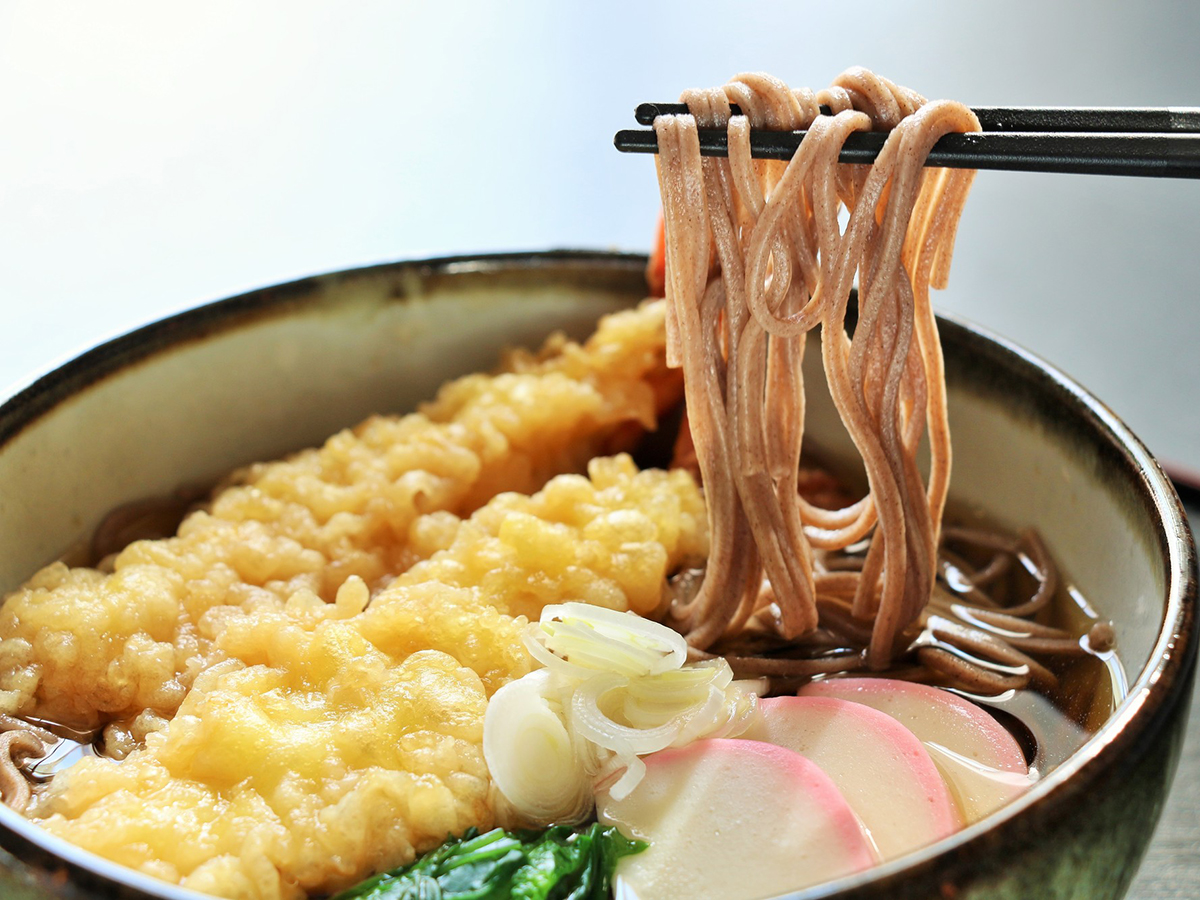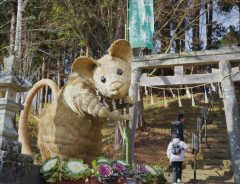
Source: よっちゃん必撮仕事人 Yotchan hissatsu shigotonin | © PIXTA
New Year’s Eve “toshikoshi soba” noodles and recommended Tokyo soba shops to enjoy them
- Tags:
- New Year / New Year's Eve / Noodles / recommendations / Soba / soba noodles / toshikoshi soba
Related Article
-

Adorable Chinese Zodiac Doughnuts from Krispy Kreme Japan Promise a Lucky New Year
-

Japanese hotel brings back popular ramen-themed rooms with restaurant atmosphere and free noodles
-

Vtuber group hololive collabs with Japan Post on New Year’s postcards and themed goods
-

Local Senior Citizens Build Beautiful Straw “Year of The Rat” Guardian In Front Of Shrine
-

Indian village disco takes over Shibuya for New Year’s Eve 2020
-

Japan fuses instant noodles and rice balls for the ultimate speedy snack


If you happen to be in Japan on December 31st and January 1st, you have an opportunity to participate in one of several Japanese New Year's customs. A popular one on New Year's Eve which is easy for foreigners to participate in is the tradition of eating 蕎麦 soba (buckwheat) noodles. Unless you're allergic to buckwheat, you might enjoy a delicious dish of soba noodles to usher in a happy new year.
Origins
But why do Japanese people eat soba noodles on this day?
During the middle of the Edo period, merchants had a custom of eating soba noodles on the last day of every month. This was called 晦日蕎麦 misoka soba or tsugomori soba (misoka meaning the last day of the month).
Soba noodles were also popular at the time as a fast food that could be quickly eaten at shops and stalls, making them convenient at the end of the month when people were typically the busiest with monthly deadlines. Eventually, the custom of eating misoka soba on the last day of every month disappeared, save the last one. New Year's Eve remained and the noodle became known as 年越し蕎麦 toshikoshi soba, literally "year-crossing soba noodles."
Meaning
Eating these noodles has a variety of meanings.
To begin with, they're seen as a way to wish for a long life, as the thin and long noodles are thought to symbolize a long lifespan. In the Edo period, soba was believed to prevent beriberi, so it was considered a kind of health food, which also bolstered the notion that you'll live longer if you eat them.
Moreover, since soba noodles are easier to cut than other types of noodles, eating them on New Year's Eve is also seen as a way to cut off any problems or bad luck from the past year.
Soba noodles are also thought to bring good fortune since Japanese goldsmiths of yore collected gold dust that scattered during their work by using soba flour dumplings.
Finally, eating soba noodles on New Year's Eve is seen as a way to improve one's luck in the coming year. This belief originated in the Kamakura Period (1192-1333) when the soba noodles distributed at a temple in Fukuoka were believed to have improved the luck of everyone who ate them the following year.
Welsh onions, traditionally eaten with toshikoshi soba also have an auspicious meaning. The pronunciation of the vegetable in Japanese, ネギ negi, has several similar-sounding verbs, such as 労ぐ negu meaning "to appease the gods" and "to comfort," 祈ぐ negu meaning "to pray," and 禰宜 negi, meaning "priest."
Timing
There are no rules about when to eat toshikoshi soba on December 31st. The only "rule," if you can call it that, is to finish eating them before the strike of midnight. As mentioned earlier, one of the meanings of toshikoshi soba is "cutting off the problems of the old year," so you might as well be done with them before the new year begins. Practically speaking, if you intend to eat them at a soba shop, many people have them for lunch since supplies at some popular shops run out before dinner time.
Added ingredients
When it comes to what ingredients you eat with your soba noodles, here too, there are no rules to follow. You can enjoy them in a soup, together with shrimp or vegetable tempura, fish cakes and other ingredients, or as is on a bamboo tray with shredded nori seaweed and tsuyu dipping broth.
There are some regional preferences, such as にしんそば nishin soba with herring in Hokkaido and Kyoto, わんこそば wanko soba (eating small bowls of soba noodles in quick succession) in Iwate Prefecture, 越前おろしそば echizen oroshi-soba paired with grated spicy daikon radish in Fukui Prefecture, くるみそば kurumi soba paired with a dipping sauce made from ground walnuts in Nagano Prefecture, on a bamboo tray with shredded nori as famous with へぎ蕎麦 hegi soba in Niigata Prefecture, and 沖縄そば okinawa soba paired with stewed pork ribs with cartilage attached in Okinawa Prefecture.
Soba shop recommendations
Even if you have no kitchen and only hot water, you can still participate in this custom by buying instant soba noodles. You won't need to look further than your local convenience store to find them. Convenience stores also sell various prepared soba soup meals which they can heat up for you in their microwave oven. If you have a stove where you live, then you can buy dry soba noodles and some tsuyu sauce and make a bowl of soba noodles yourself. Convenience stores also sell these ingredients.
However, if you'd like to enjoy your toshikoshi soba at a soba shop, here are a few shops that we've confirmed will be open on December 31st, 2022:
Asakusabashi Hyakusoba 浅草橋百そば
At Hyakusoba in Asakusabashi, you can enjoy a special soba dish made with Yamakawa wasabi called 雪板蕎麦 yuki-ita soba (itasoba being soba on a bamboo tray and yuki meaning "snow").
© SocialWire Co., Ltd.
Yamakawa wasabi, a brand of 山わさび (yamawasabi | "mountain wasabi"), otherwise known in English as horseradish, produced by 山川農園 Yamakawa Farm, a third-generation farmer in the town of Yamakawa in Tokachi, Hokkaido, is shipped directly from the farm with the soil intact to keep the root in pristine condition. When you try it, the fresh taste of mountain wasabi wafts up through your nose, and you'll enjoy a subtle sweetness on your palate. When grated for you in the store, it looks like a fresh dusting of snow on top of your soba noodles.
Yuki-ita Soba costs 930 JPY.
© SocialWire Co., Ltd.
You can also enjoy many other kinds of soba at Asakusabashi Hyakusoba. Since it's popular, they sell out of soba rather early, so you should probably think of going there for lunch, and by 2 pm at the latest. For more information, see their full menu here. They also have a special toshikoshi soba takeout set only available through advance reservation and for pick up on December 31st.
They're located at 東京都台東区柳橋1-32-5 (1-32-5 Yanagibashi Taito Ward Tokyo), a 1-minute walk from Asakusabashi Station on the JR line and Toei Metro Asakusa Line, and are open from 11:00 to 21:00 (L.O. 20:30).
Tendon Hamada 天丼はま田
Sometimes you don't need to visit a soba specialty shop for an excellent dish of toshikoshi soba.
Tendon Hamada 天丼はま田, which specializes in 天丼 tendon (tempura rice bowl), have a tasty-looking toshikoshi soba proposal.
Their 年越し蕎麦 toshikoshi soba is a soba soup bowl with tempura of shrimp, Manganji pepper (a long, green pepper with a uniquely sweet, earthy flavor from Kyoto), かき揚げkakiage (tempura made of seafood and/or vegetable chunks) of fried squid and scallop, as well as maitake mushroom. It costs 1,100 JPY (incl. tax).
© PR Times, Inc.
If you plan on dining in the store, the last order will be at 2 PM, so you should probably think of arriving early. The store opens at 10:30 AM.
You can also pre-order it as a special toshikoshi soba set for two called 年越しそば天盛りセット toshikoshi soba ten-mori setto with the same tempura ingredients for 2,000 JPY (incl. tax)
© PR Times, Inc.
To reserve, call or visit the store before December 29th and provide your name, telephone number, and the number of items you wish to order. Pick up your order at the store between 10:30 and 22:00 on December 30th or between 10:30 and 20:00 on December 31st and pay when you get there. A limited number of sets will also be available for people who haven't reserved on December 30th and 31st, but you should visit as early as possible or they may no longer be available.
The Nerima branch in Tokyo is located at 東京都練馬区関町北3-2-3 (3-2-3 Sekimachi Kita Nerima Ward Tokyo) which can be reached at 03-5927-5766. It's a 12-minute walk from 武蔵関駅 Musashi-Seki Station on the Seibu Railway Shinjuku Line.
For more information, visit their website here.
These are only two suggestions, but there are many others to choose from.